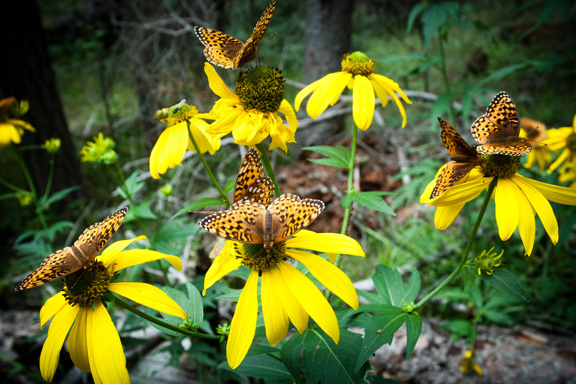Last Sunday, a couple of friends and I drove up Hyde Park Road and, just before the Aspen Vista lookout, turned onto Forest Road 102. We were headed for Aspen Ranch, the trailhead for what I remembered as one of the most beautiful hikes in the Santa Fe mountains. The 13-mile loop leads to La Junta, “the junction,” a mountain meadow where the Rio Nambe and the Rio Capulin meet. Judging from the maps of the Pacheco Fire, the meadow is now toast, but I hoped to get close enough to see what had been spared by the flames.
Long ago Aspen Ranch was the site of a boys school. In his book, An Anthropology of Everyday Life, the late Ned Hall (better known to the world as Edward T. Hall) described a year he spent there. The land is now owned by Tesuque Pueblo, and when I used to go there, maybe a decade ago, there was a sign informing hikers of a $10 parking fee. Since there was never anyone monitoring the trailhead and no visible means of making payment, I would leave a check made out to the pueblo on my windshield. It was always there when I returned, so I would keep it in the glove compartment for a future visit.
This time it was not an issue. The entire ranch was cordoned off with barbed wire and locked gates marked with “No Trespassing” signs. During my long absence, the Forest Service had built a new trailhead on the public side of the gate and cut a detour around Tesuque’s land.
The trail is called the Borrego because sheepherders once used it to herd their flocks from Chimayo to Santa Fe for market. We followed it a short distance and then turned onto another trail that descends along the Rio en Medio all the way down the mountain. Most people know this trail from the bottom end — where it starts outside the village of Rio en Medio and climbs past several waterfalls. The canyon looked as lush and shady as ever — green meadows filled with wildflowers and an astonishing number of butterflies flocking to feed on the nectar of Black Eyed Susans. It was hard to believe that just over the ridge so much devastation lay.
I returned to the same area yesterday, staying this time on the Borrego Trail. More idyllic meadows, talls stands of pine and aspen — and suddenly the smell of 10,000 acres of burnt forest. There is a short stretch where the trail follows a power line service road and, at the top of a hill, peels off and heads down to the Rio Nambe. Standing there, I looked down on a hillside of badly burnt trees. Not far in the distance whole landscapes were reduced to gray moonscapes — the way so much of the Jemez looks now. A helicopter, hovering overhead, was dropping loads of straw on denuded mountainsides. The restoration effort was already under way.
A sign that had been posted at the edge of the burn area didn’t say, in so many words, that entry was prohibited. But it gave enough good reasons to stay out — falling limbs and trees, flash floods of ash and mud, burnt-out stump holes, fire maddened nests of hornets — that I almost turned back. Most of the destruction was below the trail (it had acted as a partial fire break) so I followed it a little farther. When I reached a spot where the trail had washed out, I decided to call it a day.
It was a relief to drive home through old familiar aspen groves. I told myself that this beauty now exists because fires, long ago, had cleared the pines, opening new niches in the ecosystem — that someday, decades from now, the ashen lands of the Pacheco Fire would be as beautiful. It was too much of a stretch for my imagination. All I could honestly feel was a terrible sense of loss.
George Johnson
The Santa Fe Review

Note: This is the last of three posts looking back on the ice and fire of 2011.
